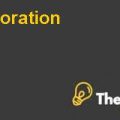
Barclays Plc. Audit risk Assessment Case Solution
Risk profile
The following document carries the critical evaluation of the audit practice over the recent internal as well as financial position of Barclays Plc. Also analyses factors that would contribute towards the success or failure in the particular industry. So in order to assess the audit risk, four business analytical produces have been adopted to determine the current position of Barclays plc.
Structure of the industry (Locally and Globally)
Multinational banking industry has seen vast expansion in the past few decades, which increased the competition of several established banking sectors in many countries. Under the case, an entry motive of new multinational banks has boosted the intense competition among all the developing as well as developed countries. Whereas some local banks also dominated in several states due to monopoly power to control.
On the other side, British multinational banking industry has its origin from 1830 to onwards. The first branches outside the UK were created during the period of 1830. The Barclays expanded their business by acquiring most of the banks between 1905 and 1916. Separate board of director will manage every branch of the bank, so that banks effectively manage their issue. Barclays is leading bank in the UK with strong international growth opportunities. The bank has strong and growing US card business alongside good balance in its revenue streams after diversification. As the branches of the banks separately assessed, it will support solid investment grade credit rating and both locally and internationally generate double-digit return on tangible equity on pro-forma adjusted basis for 2015.
Critical issues facing the industry
There are various risks faced by the industry, which directly affect many individual banks. Banks are facing many challenges in several areas, but there are four current issues in today’s market.
Customer’s expectations: many financial institutions facing more pressure to serve their customers a level of service that customer is demanding. Nowadays, most of the customers are focusing on the high technology. As there is an increase in the competition, most of the banks are using software to provide financial service to their customers. It creates big challenges for the traditional banks, because they are not able to adjust quickly to the changes in technology, culture, and facts of the industry.
Market risk: most of the banks want to sell all over the world, so they decide to diversify their portfolio in order to fulfil the need of customers. A sudden and unfavourable volatility in the interest rate and foreign currency exchange rate has a potential impact on the revenue of the banks. If there is fluctuation in the interest rate, currency exchange, and commodity price then it affects in the banking profitability. As 2015, there is the increased in the interest rates, it is difficult for the lenders to pay back their loan; most of the customers become defaulters. The commodity price becomes lower; thus, the fiscal and current account become imbalanced, which leads to natural decline in the economic growth.
The systematic risk of the financial crisis in 2008 was not not faced by just a single bank or financial institution rather the whole industry. Due to this risk, many banks collapsed while many made their way out of it. The ones that collapsed did not have a business management strategy.........................
This is just a sample partial case solution. Please place the order on the website to order your own originally done case solution











